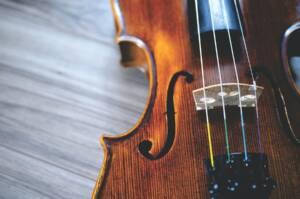From Silence to Soundtrack: The Evolution of Music in Film and TV

Music has always played a crucial role in visual storytelling, whether it be in film or television. It has the power to enhance the emotions portrayed on screen, create tension, and immerse audiences in the story being told. From the early days of silent films to the modern era of digital soundtracks, music has been an integral part of the cinematic experience.
One of the main reasons why music is so important in film and TV is its ability to evoke emotions. Music has a unique way of connecting with audiences on an emotional level, often bypassing rational thought and going straight to the heart. It can make us feel joy, sadness, fear, or excitement, and can even bring us to tears. The right piece of music can elevate a scene from good to great, and can leave a lasting impression on viewers long after they have left the theater or turned off the T
The Early Days: Silent Films and Live Music
In the early days of cinema, when films were silent, live music was used to accompany screenings. This was done to enhance the viewing experience and help set the mood for each scene. Pianists or organists would often play along with the film, improvising music that matched the action on screen. They would use their knowledge of different musical styles and techniques to create a soundtrack that complemented the visuals.
The role of the pianist or organist was crucial in creating a seamless experience for audiences. They had to be able to read the emotions portrayed by the actors and translate them into music. They also had to be able to think on their feet and adapt their playing to match any changes in the film. This required a high level of skill and creativity, as well as an understanding of how music can enhance storytelling.
The Birth of the Soundtrack: The Jazz Singer and Beyond
The introduction of synchronized sound in film, with the release of “The Jazz Singer” in 1927, marked a major turning point in the history of music in cinema. For the first time, audiences could hear the actors speaking and singing on screen, and music became an integral part of the storytelling process. The success of “The Jazz Singer” paved the way for the use of popular songs in films, as well as the creation of original scores.
The use of popular songs in films became a trend in the 1930s and 40s, with many movies featuring hit songs of the time. These songs helped to create a connection between the film and its audience, as they were already familiar with the music. They also added an extra layer of emotion to the story, as the lyrics often reflected the feelings and experiences of the characters.
The Golden Age: Classic Hollywood Musicals and Scores
The Golden Age of Hollywood saw the rise of the musical genre, with films like “Singin’ in the Rain” and “The Sound of Music” becoming iconic examples of this style. These films featured elaborate song and dance numbers, with music playing a central role in advancing the plot and developing the characters. The songs were often catchy and memorable, and became hits in their own right.
Original scores also became an important part of filmmaking during this time. Composers like Max Steiner, Bernard Herrmann, and Ennio Morricone created iconic scores that are still recognized today. These scores helped to set the mood for each scene, create tension, and enhance the emotional impact of the story. They added depth and richness to the visuals, making them more immersive for audiences.
The Rise of Pop Music: The 1960s and 70s in Film and TV
The 1960s and 70s saw a shift in popular music, with rock and roll becoming a dominant force. This had a major impact on the world of film and television, as filmmakers began to incorporate popular songs into their soundtracks. Films like “Easy Rider” and “Saturday Night Fever” used popular songs to capture the spirit of the times and create a connection with audiences.
The use of popular songs in soundtracks became a trend in the 1970s, with many films featuring hit songs that became synonymous with the movie itself. These songs helped to create a sense of nostalgia and added an extra layer of emotion to the story. They also helped to market the film, as audiences were already familiar with the music and were more likely to be drawn to the movie as a result.
The Influence of Rock and Roll: The 1980s and 90s
The 1980s and 90s saw the continued influence of rock and roll on film and T
Many films during this time featured rock music in their soundtracks, often using it to enhance action sequences or create a sense of rebellion. Films like “Top Gun” and “Pulp Fiction” became known for their iconic soundtracks, which featured popular rock songs that became hits in their own right.
Rock music also had an impact on the way films were scored during this time. Composers like Hans Zimmer and Danny Elfman began incorporating elements of rock into their scores, creating a unique blend of orchestral and electronic music. This helped to create a more modern and edgy sound, which resonated with audiences and added an extra layer of excitement to the visuals.
The Emergence of Hip-Hop: From Boyz n the Hood to Empire
The 1990s saw the rise of hip-hop in film and television, with movies like “Boyz n the Hood” and TV shows like “Empire” showcasing the genre’s influence on storytelling. Hip-hop music became an important part of these narratives, reflecting the experiences and struggles of the characters. It added an authenticity and cultural relevance to the stories, and helped to create a connection with audiences.
The use of hip-hop music in soundtracks also became more prevalent during this time. Films like “8 Mile” and “Hustle & Flow” featured original songs that were created specifically for the movie. These songs helped to advance the plot and develop the characters, while also showcasing the talent of the artists involved. They added an extra layer of depth and emotion to the story, and helped to create a more immersive experience for audiences.
The Impact of Technology: Digital Music and Sampling
The rise of digital technology in the late 20th century had a major impact on the way music was used in film and T
Digital music allowed for greater flexibility and creativity in creating soundtracks, as composers could now manipulate and edit music in ways that were not possible before. This opened up new possibilities for creating unique and innovative scores that pushed the boundaries of traditional film music.
Sampling also became a popular technique in film and TV soundtracks during this time. Sampling involves taking a small portion of an existing song and incorporating it into a new composition. This allowed filmmakers to reference popular songs or create a sense of nostalgia, while also adding their own unique twist to the music. It became a way to pay homage to the past while also pushing forward into new territory.
The Power of Music Supervisors: The Role of Licensing in Film and TV
The role of music supervisors became increasingly important in selecting music for film and TV soundtracks. Music supervisors are responsible for finding and licensing songs that fit the mood, tone, and narrative of a particular scene or project. They work closely with directors, producers, and composers to ensure that the music enhances the story being told.
Licensing also plays a crucial role in film and TV, as it allows filmmakers to use existing songs in their soundtracks. Licensing involves obtaining permission from the copyright holder to use a particular song in a film or TV show. This can be a complex and time-consuming process, as it often involves negotiating fees and terms with multiple parties. However, it is an essential part of the filmmaking process, as it allows filmmakers to create the desired emotional impact and connection with audiences.
The Future of Music in Film and TV: Virtual Reality and Beyond
The future of music in film and TV looks promising, with new technologies like virtual reality opening up new possibilities for storytelling. Virtual reality allows audiences to immerse themselves in a 360-degree world, where they can interact with the story and characters in ways that were not possible before. Music will play a crucial role in creating the atmosphere and emotional impact of these virtual worlds, helping to transport audiences to new and exciting places.
The future of music in film and TV also holds potential for new collaborations between artists from different genres and mediums. We may see more musicians crossing over into acting, or filmmakers partnering with musicians to create unique and innovative projects. The possibilities are endless, and the future is bright for music in visual storytelling.
The Enduring Legacy of Music in Visual Storytelling
In conclusion, music has always been an integral part of visual storytelling, whether it be in film or television. It has the power to evoke emotions, create tension, and enhance the overall viewing experience. From the early days of silent films to the modern era of digital soundtracks, music has played a crucial role in enhancing the stories being told on screen.
The legacy of music in film and TV is enduring, as it continues to captivate audiences and create emotional connections. Whether it be through original scores, popular songs, or innovative sound design, music has the ability to transport us to different worlds and make us feel things we never thought possible. It is a universal language that speaks to the heart and soul, and will always have a place in the world of visual storytelling.





